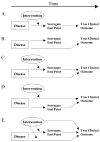Surrogate end points in pulmonary arterial hypertension: assessing the response to therapy
- PMID: 17338929
- PMCID: PMC1868503
- DOI: 10.1016/j.ccm.2006.11.005
Surrogate end points in pulmonary arterial hypertension: assessing the response to therapy
Abstract
Recent discoveries in the disease pathophysiology of pulmonary arterial hypertension have been translated into effective therapies tested in clinical trials. The studies have focused on surrogate and intermediate end points, thought to reflect quantity and quality of life, respectively. The authors present the necessary requirements for establishing the reliability and validity of such end points before they may be used dependably. The authors also review the available data, strengths, and weaknesses of potential end points in pulmonary arterial hypertension.
Figures

References
-
- Hoeper MM, Oudiz RJ, Peacock A, et al. End points and clinical trial designs in pulmonary arterial hypertension: clinical and regulatory perspectives. J Am Coll Cardiol. 2004;43:48S–55S. - PubMed
-
- Peacock A, Naeije R, Galie N, Reeves JT. End points in pulmonary arterial hypertension: the way forward. Eur Respir J. 2004;23:947–953. - PubMed
-
- Kawut SM, Palevsky HI. Surrogate end points for pulmonary arterial hypertension. Am Heart J. 2004;148:559–565. - PubMed
-
- Kawut SM, Palevsky HI. New answers raise new questions in pulmonary arterial hypertension. Eur Respir J. 2004;23:799–801. - PubMed
-
- Rich S. The current treatment of pulmonary arterial hypertension: time to redefine success. Chest. 2006;130:1198–1202. - PubMed
Publication types
MeSH terms
Substances
Grants and funding
LinkOut - more resources
Full Text Sources
Medical

